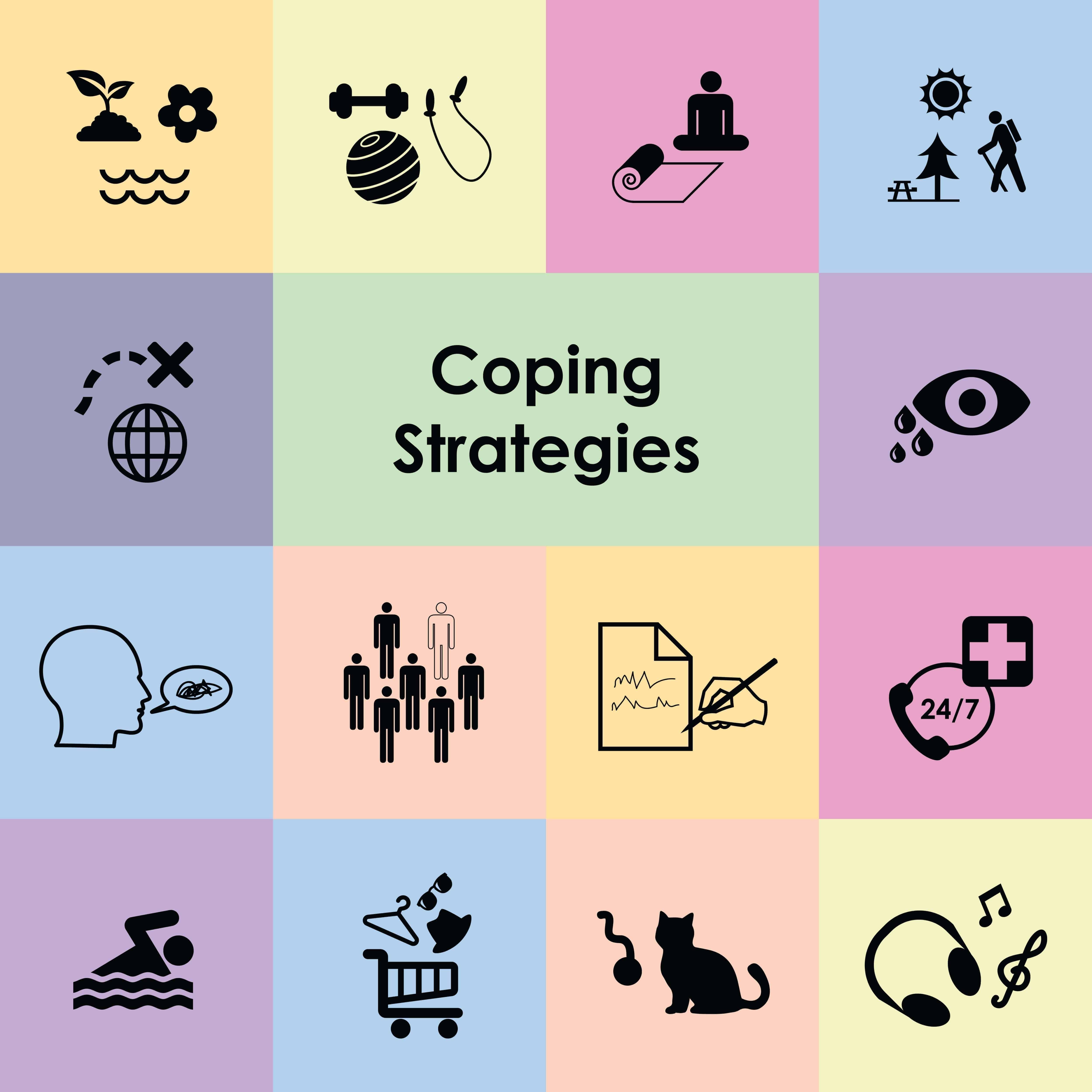
Stress is an inevitable part of life. What counts is how we deal with it — or in other words, our coping mechanisms.
Coping mechanisms are the strategies people use to deal with painful emotions and adjust to stressful life events. Naturally, some of these strategies are more effective than others; in fact, some may even have negative long-term effects on a person’s health and well-being.
Such coping mechanisms are referred to as maladaptive coping mechanisms. Below, we’ll explain in greater detail what maladaptive coping mechanisms can look like — but know that if you recognize a maladaptive coping mechanism in yourself, it’s not a life sentence.
You can actively work to build better coping mechanisms by changing maladaptive behaviors into healthier, adaptive ones… and here’s how.
What Are Maladaptive Coping Mechanisms?
Maladaptive coping mechanisms are coping strategies that work for a time but are characterized by unintended negative consequences that may render them counterproductive. These consequences can be long-term. Many mental illnesses are thought to develop partly as a result of maladaptive coping mechanisms — for example, social phobia is characterized by an avoidance of social situations that induce anxiety.
Another example of a maladaptive coping mechanism becoming a mental illness is substance abuse. Using a substance like alcohol or drugs begins as a way to help the person cope with negative feelings and then develops into a physical dependence on the substance. Hence, an important component of the treatment for substance abuse and other mental health issues involves replacing maladaptive coping mechanisms with better ones.
Some additional examples of maladaptive coping mechanisms appear below:
- Hostility: A person may engage in counterattacks by defying, abusing or blaming others to cope with their negative emotions. For example, someone who is being broken up with may hurl attacks at the person breaking up with them to feel better.
- Status-Seeking: Or, someone may overcompensate for negative emotions by way of impressing, high-achieving, attention-seeking and status-seeking behaviors. If someone has learned from their parents or caregivers that they were not good enough as they were, they may cope by attempting to earn their love with achievements and status.
- Manipulation: When a person is incapable of meeting their own needs, they may resort to dishonesty, seduction or conning to convince someone else to help them. An example of this is if a person does not get their way in an argument and covertly manipulates the other person into admitting they are right.
- Passive-Aggressiveness: Someone who is passive-aggressive may appear overly-compliant or passive, yet rebel in secret via procrastination, backstabbing, pouting, lateness or other petty means. A classic example of passive-aggressive behavior comes from one roommate leaving a sarcastic note about something their housemate has done, rather than confronting the problem face-to-face.
- Dependence: Relying on others can be healthy to a degree, but someone who uses dependence as a coping mechanism may be overly-submissive, hiding their true desires and giving into others’ demands easily. For example, a partner who fears that their significant other will leave them may allow their partner to choose everything from what they eat for dinner to how they wear their hair.
- Obsessionality: An excessive need to maintain control and strict order through planning and routine is commonly a maladaptive coping mechanism. Many people with anxiety or obsessive-compulsive disorder exhibit this behavior, holding others to rigid standards in order to cope with their uncertainty about the future.
- Social Withdrawal: Sometimes, we need to be alone for a while to sort out our feelings — but when this coping mechanism is taken to the extreme, someone may completely avoid others and shut friends and family out so they can avoid getting hurt or hurting others. Social withdrawal is frequently seen in social phobia and depression.
- Stimulation-Seeking. These compulsive behaviors are often unhealthy for us and can include excessive risk-taking, gambling, sex, shopping or too much exercise. You can easily see how any of these behaviors, when taken to the extreme, can get a person into trouble — for example, a shopaholic who uses her credit card to cope may find herself in crippling debt as a consequence of her actions.
- Addictive Behaviors. Addictive behaviors can be summarized as “too much of a good thing.” When self-soothing becomes compulsive, it becomes maladaptive. Addictions to alcohol, drugs, sex, food or gambling, among other things, are a coping mechanism that allows others to avoid directly confronting their problems via self-distraction.
- Psychological Escape. A person who wants to avoid their problems may turn inward, using fantasy, denial or dissociation to escape from their everyday life. This can be positive to a degree — for example, reading a book to escape to another world — but when taken to the extreme, it can lead to neglecting one’s real-world responsibilities or refusing to take responsibility for one’s actions.
What Are Adaptive Coping Mechanisms?
In order to understand how to change maladaptive coping mechanisms into better ones, we have to first comprehend what adaptive coping mechanisms look like in the real world. After all, for someone who has always used maladaptive coping mechanisms to deal with their emotions, it can be difficult to even imagine what a more constructive coping strategy might be.
The first step toward changing maladaptive behaviors is identifying the behaviors we wish to develop instead. Hence, below we provide a list of adaptive coping mechanisms you may want to try in place of harmful maladaptive ones.
Remember, it takes time to build a habit, and the first adaptive coping strategy you try may not work for you. Thus, it’s helpful to identify a number of strategies you can see yourself trying, in case you don’t find the right fit immediately. Afterward, we’ll talk about how to put these positive coping mechanisms into place in your life to help you shift from relying on maladaptive coping strategies to utilizing more constructive ones.
Here are some common adaptive coping mechanisms that you may want to try on for size:
- Adaptation: Humans are an extremely adaptive species, meaning we can learn to adjust to any change that comes our way. Someone who experiences a big life change, such as a move to a new state or a staggering disappointment, and decides to use it as a positive opportunity is using adaptation as a constructive coping mechanism.
- Compartmentalization: Occasionally, we may have thoughts or beliefs that conflict with one another. We may learn to live by different values in the different groups to which we belong. This can be a positive coping mechanism because it can lead us to get outside our comfort zone — by creating a new “compartment,” we can rationalize doing something we may not normally do, even if it is good for us.
- Crying: Do you ever find that you feel better after a long cry? Some of us have been taught to view tears as weakness, but in fact, they can be a form of catharsis, allowing us to release pent-up emotions. By crying, we can also seek comfort from others, as our tears stimulate the natural empathy in others. In other words, crying can be a perfectly healthy coping mechanism!
- Displacement: When we are unable to take action on our intended target, we may displace our actions onto another suitable target. This can have negative consequences — for example, if we yell at our partner after being yelled at by our boss at work — but can also be a constructive coping mechanism in other situations. For example, someone who is angry with a friend or coworker may attend a boxing class where they can take out their feelings in a more constructive way.
- Idealization: When we choose or desire something, we ignore the negative qualities of that person or thing and focus on the good. This allows us to cope with the uncertainty of thinking that we have made the wrong decision. While idealization can be harmful when taken to the extreme, it can also help us cope with a negative situation by focusing on the positive.
- Identification: Think of somebody whom you admire greatly. Whether that is someone in your life or a famous person whom you look up to, you may find yourself trying to channel that person. An example is when someone asks themself a question such as, “What would Oprah do?” and copies her behavior to help them act in a way they deem acceptable.
- Rituals. You may think of rituals as a negative coping mechanism or imagine them as obsessive behaviors, such as those seen in Obsessive-Compulsive Disorder. However, many rituals are small and harmless — and when used sparingly, they can give us enough time to gather our thoughts, calm down and respond to a situation in a more constructive way. An example of a helpful ritual could be washing dishes or exercising in order to cope with stress.
- Post-Traumatic Growth. Traumatic events often change us irrevocably — sometimes, for the better! When someone becomes more resilient as a result of a traumatic event, they may be undergoing post-traumatic growth. They may begin to spend more time helping others and learn to appreciate each day as it comes. This allows someone to find meaning and positivity in an event that hurt them; for example, if a mother who has lost a child to cancer begins a charity, they are exhibiting post-traumatic growth.
- Sublimation: Sublimation can be defined as channeling our energy into positive activities. In sublimation, we may have an urge to do something harmful and self-destructive, but instead, take that urge and put it toward another activity. The result can be a constructive and valuable piece of work — like a painting or novel borne out of negative emotions.
- Substitution: When we take something that leads to discomfort and replace it with something that does not, we are using substitution to cope. Unlike displacement, we don’t move our behavior from one target to another, but rather use a simple replacement strategy — such as calling a friend to avoid making an uncomfortable phone call. However, if we use it too often, substitution can become procrastination, which is no longer helpful to us.
- Undoing: Someone who does something wrong may compensate by performing an action that partially undoes the wrongdoing. Our action has conflicted with our values and we must do something to alleviate our shame. This can be a form of apology through action, even if we don’t use the words “I’m sorry.” An example is buying your partner flowers after a fight.

How to Build Better Coping Mechanisms
In order to change a negative coping mechanism to a positive one, we have to identify a healthier coping mechanism that we can substitute for the unhealthy one. This should be something measurable and attainable that we can do instead of performing a maladaptive coping behavior. For example, displacement may be a healthier coping mechanism than passive-aggressiveness — and is appropriate for allowing us to cope with the same emotions of anger and frustration. However, undoing may be less helpful to us if we are not the person who has done something wrong.
Building healthier habits takes time but can be as simple as committing to change for two to four weeks. Once we’ve managed to use healthier coping mechanisms for that amount of time, we may find that our healthy coping strategies have become automatic and we no longer have to think about using them.
However, it’s important to note that some coping mechanisms are more difficult to replace on our own than others. Some maladaptive coping mechanisms, such as self-harm or compulsive behavior, may require outside intervention to be overcome. Our trained therapists here at The Meadowglade can help you replace unhealthy habits with more constructive ones using the science of psychology, while monitoring you closely to keep you safe from self-destructive urges.
